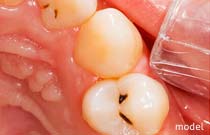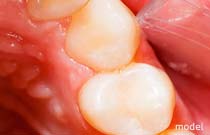Visit Our Office 77 Rolling Oaks Dr., Thousand Oaks, CA 91361(805) 379-5262
Onlays, Crowns, and Composite Fillings
Onlays are lab fabricated restorations that have many advantages over crowns and fillings, depending on the situation. According to Dr. Gordan Christenson from cliniciansreport.org, whom is one of the most highly regarded experts on cosmetic and general dentistry, a large composite filling that extends between the teeth has an average life space of only 3 years. That means that these fillings need to be replaced multiple times over the course of the tooth.
Each replacement results in loss of tooth structure and therefore increases chances of needing a root canal on that tooth. Onlays and crowns have a much longer life span and therefore not only will provide better contour and esthetics, a stronger restoration, better fit, better contact, and will also last significantly longer.
Here are the Advantages of an Onlay Over a Larger Filling
Superior Fit
Inlays and onlays offer a conservative preparation that preserves as much healthy tooth as possible. They are a great choice if you have minimal to moderate tooth decay that extends into a flossing area, offering an excellent alternatives to full coverage crowns.
Tooth Color
Boasting esthetic longevity, inlays and onlays are not likely to discolor over time as tooth-colored resin fillings often do.
Tooth Structure Safeguard
Inlays and onlays preserve the maximum amount of healthy tooth structure while restoring decayed or damaged areas, helping to ensure functional longevity.
Easy Tooth Cleaning
Because the fit is tailored at all edges and the preparation minimal, your tooth can be easier to clean than it would be with full coverage restorative alternatives such as a dental crown. Composite fillings can shrink during the curing process, whereas prefabricated porcelain or gold inlays and onlays will not (ensuring a precise fit).
Tight Space Fulfillments
If you have a cavity between your teeth, consider an inlay rather than a direct composite filling. Inlays are better at sealing teeth to keep out bacteria; they are easy to clean, will not stain, and offer exceptional longevity.
Strength and Stability
Inlays and onlays are extremely stable restorative solutions for the treatment of decay. The superior fit and durable material make inlays and onlays a stable choice that can actually strengthen a damaged tooth.
Weak Tooth Protector
An onlay can protect the weak areas of a tooth. The procedure does not require the complete reshaping of the tooth.
Inlay and Onlay Materials are Evolving
The materials used to fabricate inlays and onlays continue to evolve and become more natural and tooth-like in terms of structure, how they wear, and their longevity. The use of inlays and onlays for restorative purposes is not likely to be replaced by another treatment any time soon due to the combination of excellent functional longevity and esthetic naturalness associated with inlays and onlays. In fact, maintaining tooth color over the course of your lifetime with an inlay or onlay may be further enhanced as the materials continue to improve, adding to the esthetic value of the restoration.



